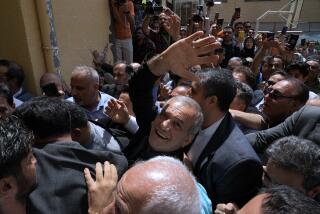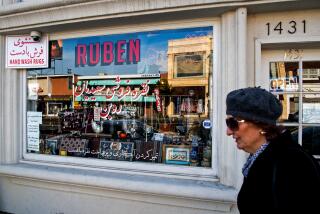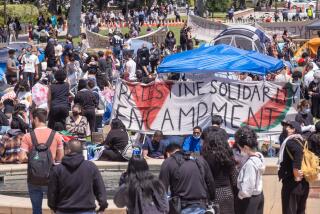Iranian protests revive icons of revolutions past
- Share via
CAIRO — The icons of revolutions past have found rebirth in Tehran.
Opposition leader Mir-Hossein Mousavi has been cast on Twitter as the “Gandhi of Iran” who speaks of his own martyrdom and, while not naturally an inspiring figure, has led hundreds of thousands of protesters into the streets. In criticizing the crackdown in Tehran, President Obama has quoted Martin Luther King Jr. and reminded the Iranian government that “the world is watching.”
Rebellion is about passion, but it’s driven by universal themes and images. It is moved by the clear delineation of two sides, which in Iran’s case are a police state, where militias roam and camouflage-clad police race around on motorcycles, and a protest movement humming with text messages citing bygone heroes and video of anonymous bloodied hands rising toward cameras.
Twitter may be the sound bite of the new century, but it takes more than 140 characters to rally a nation. The electronic discourse streaming out of Iran onto online social networks feeds on images that offer the power of poems and anthems. Hence the references to King and Mohandas Gandhi -- unimpeachable moral authorities -- against the stony visage of Iranian supreme leader Ali Khamenei, the white-bearded ayatollah who has scolded protesters and sent out security forces to force them back.
These dueling images, while not articulating the complex scope of what’s unfolding in Iran, play out in the media and in opposition slogans. They skip through cyberspace. A recent exchange between three people commenting on a protest video posted on YouTube reveals how such visceral forces are at work instigating international, multicultural debate over Iran’s fate:
“Imagine all these people marching straight to the government house and taking the so called ‘dictators’ out of power. I tell you no force will be able to stop them.”
Reply: “No, no, no, no. Did nobody learn from Ghandi!? Violence begets violence, it solves nothing. They toppled the British in India without raising their fists, they can do it here as well. It just takes time and dedication, persistence and unfortunately suffering, but a peaceful force will always win out over a violent one. Google Ghandi and learn something.”
Reply: “Someone pointed out Gandhi and MLK as an example of peaceful protesting. Here’s my take on that: MLK was not facing a dictatorship, so it doesn’t apply. Gandhi had a unique situation: peaceful protest worked here because he only had to convince the people of India that they should not be governed by foreign powers (England). In Iran’s case, there are no foreign powers to rise up against, only a dictatorship that also happens to have millions of local supporters. Violence is necessary here.”
How events will turn out in coming days and weeks is unpredictable.
Mousavi has called the reelection of President Mahmoud Ahmadinejad fraudulent and has stated the country must be purged of lies and dishonesty.
Khamenei has not relented, relying instead on what he sees as the power of his own image: a devout and patriotic cleric often appearing in front of photographs of Ayatollah Ruhollah Khomeini, the revered leader of the 1979 Islamic Revolution that toppled the shah.
On Saturday, Obama subtly challenged Khamenei’s handling of the unrest by quoting King: “The arc of the moral universe is long, but it bends toward justice.”
Protesters in the streets of Tehran have been holding up placards quoting Gandhi: “First they ignore you, then they laugh at you, then they fight you, then you win.”
All this in real time. The world’s living room has turned into the world’s Internet cafe. Iran is the story, everyone’s connected. The tale never sleeps. Pictures are endless: fires in the street, stones hurled at helmeted police, tear gas, a green banner slinking like a snake over a crowd. Some become instantly iconic, such as the video posted Saturday on YouTube, of a young woman -- later identified as Neda Agha-Soltan -- falling to the ground and dying after being shot.
A man tries to stanch the blood flowing from her chest. Blood runs out of her mouth. Other men surround her. The camera, like an invited voyeur, moves and she seems to glance at it in the moments before death. The image of the young woman in bluejeans lying on the street played in endless loops.
One comment on YouTube said: “That gave me the chills the way she stared at the camera RIP.”
Before Facebook and tweets, other icons were summoned.
In his 1982 book, “Shah of Shahs,” Polish writer Ryszard Kapuscinski recounted the Islamic Revolution with a keen sense of images. In a conversation with a rug seller, Kapuscinski used the Iranian carpet as a metaphor for a nation that had endured revolt and was seeking a better future:
“Carpets are things that last -- a good carpet will retain its color for centuries. In this way, living in a bare, monotonous desert, you seem to be living in an eternal garden from which neither color nor freshness ever fades. Then you can continue imagining the fragrance of the garden, you can listen to the murmur of the stream and the song of the birds. And then you feel whole, you feel eminent, you are near paradise, you are a poet.”
--
More to Read
Sign up for Essential California
The most important California stories and recommendations in your inbox every morning.
You may occasionally receive promotional content from the Los Angeles Times.














